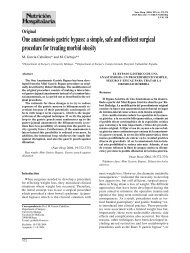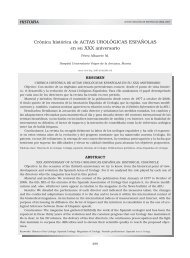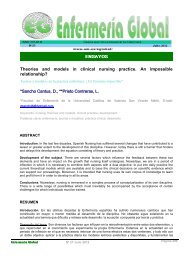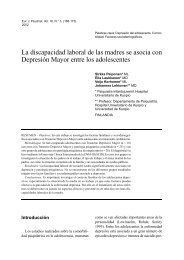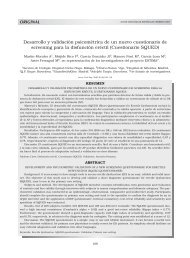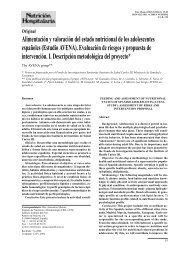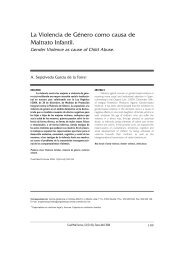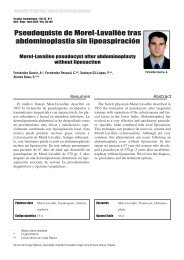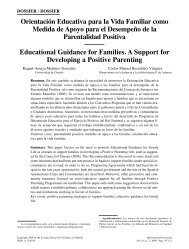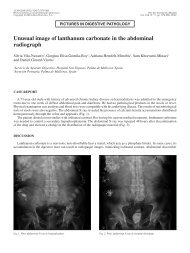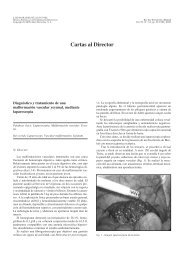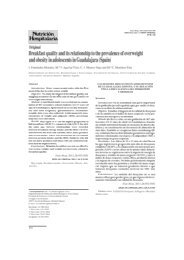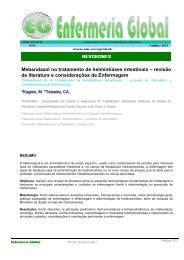Tratamiento tópico con Imiquimod crema al 5% de la enfermedad de ...
Tratamiento tópico con Imiquimod crema al 5% de la enfermedad de ...
Tratamiento tópico con Imiquimod crema al 5% de la enfermedad de ...
You also want an ePaper? Increase the reach of your titles
YUMPU automatically turns print PDFs into web optimized ePapers that Google loves.
NOTA CLÍNICA<br />
<strong>Tratamiento</strong> <strong>tópico</strong> <strong>con</strong> <strong>Imiquimod</strong> <strong>crema</strong> <strong>al</strong> <strong>5%</strong> <strong>de</strong> <strong>la</strong> <strong>enfermedad</strong><br />
<strong>de</strong> Bowen <strong>de</strong>l pene<br />
E. <strong>de</strong> Diego Rodríguez, A. Vil<strong>la</strong>nueva Peña, A. Hernán<strong>de</strong>z Castrillo, J.Mª Gómez Ortega*<br />
Servicio <strong>de</strong> Urología. *Servicio <strong>de</strong> Anatomía-patológica. Hospit<strong>al</strong> Comarc<strong>al</strong> <strong>de</strong> Laredo (Cantabria).<br />
Actas Urol Esp 2005; 29 (8): 797-800<br />
RESUMEN<br />
TRATAMIENTO TOPICO CON IMIQUIMOD CREMA AL <strong>5%</strong> DE LA ENFERMEDAD DE BOWEN<br />
DEL PENE<br />
Presentamos una <strong>al</strong>ternativa más <strong>de</strong> tratamiento para <strong>la</strong>s neop<strong>la</strong>sias intraepiteli<strong>al</strong>es <strong>de</strong> pene (<strong>enfermedad</strong><br />
<strong>de</strong> Bowen) mediante <strong>la</strong> aplicación tópica <strong>de</strong> imiquimod <strong>crema</strong> <strong>al</strong> <strong>5%</strong> 3 días <strong>al</strong>ternos a <strong>la</strong> semana<br />
durante 5 semanas. El imiquimod es una imidazoquinolona, modificador <strong>de</strong> <strong>la</strong> respuesta inmune<br />
<strong>con</strong> efectos antivir<strong>al</strong> y antitumor<strong>al</strong> indirectos, que presenta escasos efectos secundarios a nivel loc<strong>al</strong><br />
y que pue<strong>de</strong> <strong>con</strong>stituir una opción más en el tratamiento <strong>de</strong> <strong>la</strong> <strong>enfermedad</strong> <strong>de</strong> Bowen <strong>de</strong>l pene.<br />
P<strong>al</strong>abras c<strong>la</strong>ve: Carcinoma in situ. Neop<strong>la</strong>sia <strong>de</strong> pene. Neop<strong>la</strong>sia intraepiteli<strong>al</strong>.<br />
ABSTRACT<br />
TREATMENT OF BOWEN`S DISEASE OF THE PENIS WITH IMIQUIMOD <strong>5%</strong> CREAM<br />
We present an <strong>al</strong>ternative treatment of the intraepitheli<strong>al</strong> neop<strong>la</strong>sms of penis (Bowen`s disease), the<br />
topic<strong>al</strong> application of imiquimod <strong>5%</strong> cream. It was applied 3 times weekly for 5 weeks. <strong>Imiquimod</strong> is<br />
an imidazoquinolone immune response modifier that has been shown to have indirect antivir<strong>al</strong> and<br />
antitumor effects with few adverse effects. <strong>Imiquimod</strong> <strong>5%</strong> cream may represent an <strong>al</strong>ternative treatment<br />
option for Bowen`s disease.<br />
Keywords: Carcinoma in situ. Penile neop<strong>la</strong>sms. Intraepitheli<strong>al</strong> neop<strong>la</strong>sms.<br />
Las neop<strong>la</strong>sias intraepiteli<strong>al</strong>es a nivel <strong>de</strong>l pene<br />
han sido <strong>de</strong>scritas en <strong>la</strong> literatura indistintamente<br />
<strong>con</strong> varios nombres: eritrop<strong>la</strong>sia <strong>de</strong><br />
Queyrat, <strong>enfermedad</strong> <strong>de</strong> Bowen, carcinoma in<br />
situ, lo cu<strong>al</strong> genera a menudo <strong>con</strong>fusión.<br />
La eritrop<strong>la</strong>sia <strong>de</strong> Queyrat fue <strong>de</strong>scrita inici<strong>al</strong>mente<br />
en 1891 por Tarnovsky y <strong>de</strong>be su nombre<br />
a Queyrat quien en 1911 aplica este término a<br />
unas lesiones rojizas, en forma <strong>de</strong> p<strong>la</strong>ca sobreelevada,<br />
bien <strong>de</strong>limitadas, loc<strong>al</strong>izadas en pene1 .<br />
Sulzberger y Satenstein asocian histológicamente<br />
esta entidad a un carcinoma in situ <strong>de</strong> célu<strong>la</strong>s<br />
escamosas2 .<br />
En 1912 Bowen <strong>de</strong>scribe en 2 pacientes unas<br />
lesiones muy simi<strong>la</strong>res a <strong>la</strong> eritrop<strong>la</strong>sia <strong>de</strong> Queyrat,<br />
loc<strong>al</strong>izadas en extremida<strong>de</strong>s inferiores, que tam-<br />
797<br />
ACTAS UROLÓGICAS ESPAÑOLAS SEPTIEMBRE 2005<br />
bién podían aparecer en pene, <strong>con</strong>stituyendo histológicamente<br />
un carcinoma in situ <strong>de</strong> célu<strong>la</strong>s<br />
cutáneas 1,2 .<br />
Por lo tanto, si ambas entida<strong>de</strong>s <strong>con</strong>stituyen<br />
propiamente un carcinoma in situ <strong>de</strong>s<strong>de</strong> el punto<br />
<strong>de</strong> vista histológico, el término <strong>de</strong> lesiones preneoplásicas,<br />
ampliamente utilizado, no sería correcto<br />
y sí quizá más apropiado el <strong>de</strong> neop<strong>la</strong>sia intraepiteli<strong>al</strong>,<br />
siendo por tanto dos entida<strong>de</strong>s potenci<strong>al</strong>mente<br />
invasivas a nivel loc<strong>al</strong> que requieren<br />
tratamiento 1,2 .<br />
La <strong>enfermedad</strong> <strong>de</strong> Bowen extragenit<strong>al</strong> parece<br />
estar re<strong>la</strong>cionada etiológicamente <strong>con</strong> <strong>la</strong> exposición<br />
crónica <strong>al</strong> sol y el <strong>con</strong>tacto <strong>con</strong> arsénico y<br />
<strong>de</strong>rivados; en el caso <strong>de</strong> <strong>la</strong> <strong>enfermedad</strong> genit<strong>al</strong> es<br />
<strong>la</strong> infección por Papiloma virus el agente etiológi-
co más implicado 3-5 (fundament<strong>al</strong>mente el serotipo<br />
16, en menor porcentaje el 18 y a gran distancia<br />
otros serotipos 31, 33, 35, 39, 51). Wie<strong>la</strong>nd 6<br />
argumenta que <strong>la</strong> presencia <strong>de</strong>l serotipo 8 pudiese<br />
ayudar a diferenciar una eritrop<strong>la</strong>sia <strong>de</strong><br />
Queyrat <strong>de</strong> una <strong>enfermedad</strong> <strong>de</strong> Bowen.<br />
Las opciones <strong>de</strong> tratamiento <strong>de</strong> estas lesiones<br />
son múltiples 1,7,8 <strong>con</strong> resultados estéticos, funcion<strong>al</strong>es<br />
y <strong>de</strong> curación variables y así se ha<br />
recurrido tradicion<strong>al</strong>mente a <strong>la</strong> exéresis <strong>de</strong> <strong>la</strong><br />
lesión, criocirugía, radioterapia, aplicación tópica<br />
<strong>de</strong> 5-fluoruracilo y más recientemente <strong>la</strong>serterapia.<br />
Presentamos una <strong>al</strong>ternativa más <strong>de</strong> tratamiento<br />
<strong>de</strong> <strong>la</strong>s neop<strong>la</strong>sias intraepiteli<strong>al</strong>es <strong>de</strong> pene<br />
para el urólogo, <strong>con</strong>sistente en <strong>la</strong> aplicación tópica<br />
<strong>de</strong> imiquimod <strong>crema</strong> <strong>al</strong> <strong>5%</strong>, un potente modu<strong>la</strong>dor<br />
<strong>de</strong> <strong>la</strong> respuesta inmune, no habiendo en<strong>con</strong>trado<br />
en <strong>la</strong> revisión <strong>de</strong> <strong>la</strong> literatura urológica<br />
ninguna referencia a esta opción terapéutica.<br />
CASO CLÍNICO<br />
Paciente varón <strong>de</strong> 68 años <strong>de</strong> edad que acu<strong>de</strong><br />
a <strong>con</strong>sulta por disfunción eréctil <strong>de</strong> varios meses<br />
<strong>de</strong> evolución.<br />
Como antece<strong>de</strong>ntes <strong>de</strong> interés únicamente <strong>de</strong>stacan<br />
hipertensión arteri<strong>al</strong>, psoriasis e hiperuricemia<br />
en tratamiento médico.<br />
A <strong>la</strong> exploración l<strong>la</strong>ma <strong>la</strong> atención una lesión<br />
enrojecida, bril<strong>la</strong>nte, sobreelevada y friable en<br />
cara dors<strong>al</strong> <strong>de</strong> g<strong>la</strong>n<strong>de</strong> hasta surco b<strong>al</strong>ano-prepuci<strong>al</strong><br />
(Fig. 1), a <strong>la</strong> cu<strong>al</strong> el paciente no daba importancia<br />
dado que no le originaba sintomatología<br />
<strong>al</strong>guna.<br />
FIGURA 1. Aspecto macroscópico <strong>de</strong> lesión peneana.<br />
E. <strong>de</strong> Diego Rodríguez, et <strong>al</strong>./Actas Urol Esp 2005; 29 (8): 797-800<br />
798<br />
Se practicó biopsia bajo anestesia loc<strong>al</strong> <strong>de</strong><br />
dicha zona, cuyo informe anátomo-patológico fue<br />
<strong>de</strong> neop<strong>la</strong>sia intraepiteli<strong>al</strong> <strong>de</strong> pene (<strong>enfermedad</strong><br />
<strong>de</strong> Bowen), mostrándose un epitelio engrosado<br />
<strong>con</strong> célu<strong>la</strong>s hipercromáticas y atípicas (Fig. 2).<br />
Se instauró tratamiento <strong>tópico</strong> <strong>con</strong> imiquimod<br />
<strong>crema</strong> <strong>al</strong> <strong>5%</strong>, 3 aplicaciones seman<strong>al</strong>es a días<br />
<strong>al</strong>ternos durante 5 semanas.<br />
La tolerancia <strong>al</strong> tratamiento fue buena, apareciendo<br />
fundament<strong>al</strong>mente reacciones a nivel loc<strong>al</strong><br />
<strong>de</strong>l tipo prurito y sensación <strong>de</strong> quemazón, eritema<br />
y <strong>de</strong>scamación durante <strong>la</strong>s primeras aplicaciones y<br />
también adherencias prepuci<strong>al</strong>es referidas por el<br />
paciente como muy molestas, por lo que se le practicó<br />
circuncisión <strong>al</strong> inicio <strong>de</strong>l tratamiento.<br />
A los 15 días <strong>de</strong> fin<strong>al</strong>izadas <strong>la</strong>s aplicaciones se<br />
revisó <strong>la</strong> lesión presentando una franca mejoría<br />
estética (Fig. 3), habiendo <strong>de</strong>saparecido los efectos<br />
secundarios <strong>de</strong>l tratamiento.<br />
Se re<strong>al</strong>izó nueva biopsia <strong>de</strong> <strong>la</strong> zona tratada<br />
<strong>con</strong>firmándose <strong>la</strong> ausencia <strong>de</strong> atípias celu<strong>la</strong>res<br />
en el epitelio, presentando una intensa reacción<br />
inf<strong>la</strong>matoria crónica (Fig. 4).<br />
A los 6 meses <strong>de</strong> seguimiento <strong>de</strong>l paciente no<br />
aparecieron signos clínicos <strong>de</strong> recidiva en lugar<br />
<strong>de</strong> <strong>la</strong> lesión.<br />
DISCUSIÓN<br />
La <strong>enfermedad</strong> <strong>de</strong> Bowen <strong>de</strong>l pene <strong>con</strong>stituye<br />
un carcinoma in situ <strong>de</strong>s<strong>de</strong> el punto <strong>de</strong> vista histológico<br />
<strong>con</strong> mayor riesgo <strong>de</strong> evolución hacia un<br />
carcinoma invasivo (10%) que el Bowen extragenit<strong>al</strong><br />
7,8 .<br />
La biopsia <strong>de</strong> <strong>la</strong> lesión nos aportará el diagnóstico<br />
y <strong>la</strong> vez nos diferenciará esta lesión <strong>de</strong> <strong>la</strong><br />
b<strong>al</strong>anitis p<strong>la</strong>smocelu<strong>la</strong>r o b<strong>al</strong>anitis <strong>de</strong> Zoom, entidad<br />
benigna, cuyo tratamiento se limita en gener<strong>al</strong><br />
a <strong>la</strong> circuncisión. 8<br />
En 1999 Cox y Morton 7 establecen <strong>la</strong>s guías<br />
<strong>de</strong> tratamiento para <strong>la</strong> <strong>enfermedad</strong> <strong>de</strong> Bowen<br />
genit<strong>al</strong>: escisión, criocirugía, cirugía <strong>de</strong> Mohs, radioterapia,<br />
aplicación tópica <strong>de</strong> 5-fluoruracilo,<br />
fototerapia dinámica e incluso interferón-α y γ vía<br />
sistémica e intr<strong>al</strong>esion<strong>al</strong>mente.<br />
En el 2001, Mackenzzie-Word 9 utiliza un tratamiento<br />
<strong>tópico</strong> a base <strong>de</strong> una imidazoquinolona<br />
(imiquimod) en 16 pacientes diagnosticados <strong>de</strong><br />
<strong>enfermedad</strong> <strong>de</strong> Bowen extragenit<strong>al</strong>, <strong>con</strong> una respuesta<br />
<strong>al</strong> tratamiento <strong>de</strong> un 93%.
FIGURA 2. Neop<strong>la</strong>sia intraepiteli<strong>al</strong> <strong>de</strong> pene. H. E. 400x.<br />
FIGURA 3. Aspecto estético tras tratamiento <strong>tópico</strong> <strong>de</strong> <strong>la</strong><br />
lesión.<br />
E. <strong>de</strong> Diego Rodríguez, et <strong>al</strong>./Actas Urol Esp 2005; 29 (8): 797-800<br />
799<br />
El imiquimod <strong>con</strong>stituye un modu<strong>la</strong>dor <strong>de</strong> <strong>la</strong><br />
respuesta inmune 10 que actúa activando macrófagos<br />
y otras célu<strong>la</strong>s mediante su unión a receptores<br />
<strong>de</strong> superficie, induciendo <strong>la</strong> secreción <strong>de</strong> citoquinas<br />
pro-inf<strong>la</strong>matorias <strong>de</strong>l tipo interferón α, factor <strong>de</strong><br />
necrosis tumor<strong>al</strong> α e interleuquina 2 y otras <strong>de</strong>l<br />
tipo interleuquina 1α, 6, 8, 12, interferón γ.<br />
Asimismo esta imidazoqinolona parece presentar<br />
una actividad antivir<strong>al</strong> indirecta re<strong>la</strong>cionada<br />
<strong>con</strong> un aumento <strong>de</strong> <strong>la</strong> síntesis <strong>de</strong> 2´-5´-oligosintetasa<br />
11 , lo que <strong>la</strong> hace particu<strong>la</strong>rmente efectiva<br />
en el tratamiento <strong>de</strong> <strong>la</strong>s infecciones vir<strong>al</strong>es<br />
genit<strong>al</strong>es.<br />
Su aplicación se re<strong>al</strong>iza tópicamente, sin vendaje<br />
oclusivo, 3 días a <strong>la</strong> semana durante 5 semanas.<br />
Los efectos adversos más frecuentes suelen<br />
ser reacciones cutáneas loc<strong>al</strong>es <strong>de</strong>l tipo prurito,<br />
eritema, <strong>de</strong>scamación, erosiones, ulceraciones,<br />
sinequias prepuci<strong>al</strong>es, siendo en gener<strong>al</strong><br />
bien toleradas 12-19 .<br />
Hasta <strong>la</strong> fecha no son muchas <strong>la</strong>s referencias<br />
en<strong>con</strong>tradas sobre el uso <strong>de</strong> imiquimod <strong>tópico</strong><br />
para el carcinoma in situ <strong>de</strong> pene, y ninguna <strong>de</strong><br />
el<strong>la</strong>s en <strong>la</strong> literatura urológica; el primer caso fue<br />
aportado por Cook-Bol<strong>de</strong>n 12 <strong>con</strong> un seguimiento<br />
<strong>de</strong> 3 meses sin recidiva <strong>al</strong> igu<strong>al</strong> que Danielsen 13 ,<br />
Thai 14 presenta un nuevo paciente <strong>con</strong> 6 meses<br />
<strong>de</strong> seguimiento, Orengo 15 aporta un caso más <strong>con</strong><br />
FIGURA 4. Ausencia <strong>de</strong> célu<strong>la</strong>s atípicas, <strong>con</strong> reacción inf<strong>la</strong>matoria crónica. H. E. 200 y 400x.
14 meses <strong>de</strong> evolución, Schroe<strong>de</strong>r 16 <strong>de</strong>scribe un<br />
paciente <strong>con</strong> buena respuesta <strong>al</strong> tratamiento sin<br />
evi<strong>de</strong>ncia clínica <strong>de</strong> recidiva a los 18 meses,<br />
Arlette 17 presenta <strong>la</strong> mayor serie <strong>de</strong> 5 pacientes <strong>con</strong><br />
un seguimiento medio entre 3 y 12 meses, Mic<strong>al</strong>i 18<br />
aporta 2 casos más sin recidiva a los 4 y 6 meses y<br />
por último, Kaspari hace referencia <strong>al</strong> uso <strong>de</strong> imiquimod<br />
para un caso <strong>de</strong> Eritrop<strong>la</strong>sia <strong>de</strong> Queyrat.<br />
CONCLUSIONES<br />
Pensamos que <strong>la</strong> aplicación tópica <strong>de</strong> imiquimod<br />
<strong>5%</strong> pue<strong>de</strong> representar una <strong>al</strong>ternativa más<br />
<strong>de</strong> tratamiento para <strong>la</strong>s neop<strong>la</strong>sias intraepiteli<strong>al</strong>es<br />
<strong>de</strong>l pene por su fácil aplicación, escasos efectos<br />
secundarios y excelentes resultados estéticos<br />
y funcion<strong>al</strong>es, precisando un seguimiento el<br />
paciente <strong>al</strong> igu<strong>al</strong> que cu<strong>al</strong>quier otra mod<strong>al</strong>idad <strong>de</strong><br />
tratamiento y <strong>la</strong> <strong>con</strong>firmación mediante biopsia<br />
profunda <strong>de</strong> <strong>la</strong> lesión y <strong>de</strong> sus bor<strong>de</strong>s <strong>de</strong> <strong>la</strong><br />
ausencia <strong>de</strong> carcinoma.<br />
En caso <strong>de</strong> que el paciente no esté circuncidado<br />
creemos a<strong>con</strong>sejable su re<strong>al</strong>ización <strong>al</strong> tiempo<br />
que se practica <strong>la</strong> biopsia, por <strong>la</strong>s sinequias que<br />
<strong>la</strong> aplicación <strong>de</strong> <strong>la</strong> <strong>crema</strong> pue<strong>de</strong> producir, <strong>con</strong>tribuyendo<br />
a <strong>la</strong> vez <strong>al</strong> tratamiento si <strong>la</strong> loc<strong>al</strong>ización<br />
es prepuci<strong>al</strong> y también a disminuir <strong>la</strong> posibilidad<br />
<strong>de</strong> recidivas.<br />
REFERENCIAS<br />
1. Gerber GS. Carcinoma in situ of the penis. J.Urol 1994;151:<br />
829-833.<br />
2. Kaye V, Zhang G, Dehner LP, Fr<strong>al</strong>ey EE. Carcinoma in situ<br />
of the penis. Is distinction between erythrop<strong>la</strong>sia of Queyrat<br />
and Bowen`s disease relevant? Urology 1990;36:479-482.<br />
3. M<strong>al</strong>ek RS, Goellner JR, Smith TF, Espy MJ, Cupp MR. Human<br />
papillomavirus infection and intraepitheli<strong>al</strong>, in situ<br />
and invasive carcinoma of penis. Urology 1993;42:159-170.<br />
4. Cupp MR, M<strong>al</strong>ek RS, Goellner JR, Smith TF, Espy MJ. The<br />
<strong>de</strong>tection of human papillomavirus <strong>de</strong>oxyribonucleic acid in<br />
intraepitheli<strong>al</strong>, in situ, verrucous and invasive carcinoma of<br />
the penis. J. Urol 1995;154:1024-1029.<br />
5. Gómez I, Gómez E, Con<strong>de</strong> S, Maganto E, Navio S, Allona A.<br />
Infección por Papilloma virus en el hombre. Estado actu<strong>al</strong>.<br />
Actas Urol Esp 2005;29:365-372.<br />
E. <strong>de</strong> Diego Rodríguez, et <strong>al</strong>./Actas Urol Esp 2005; 29 (8): 797-800<br />
800<br />
16. Wie<strong>la</strong>nd U, Jurk S, Weissenborn S, Krieg T, Pfister H,<br />
Ritzkowsky A. Erytrop<strong>la</strong>sia of Queyrat:coinfection with<br />
cutaneous carcinogenic human papillomavirus type 8 and<br />
genit<strong>al</strong> papillomaviruses in a carcinoma in situ. J. Invest.<br />
Dermatol 2000;115:396-401.<br />
17. Cox NH, Eedy DJ, Morton CA. Gui<strong>de</strong>lines for the management<br />
of Bowen`s disease. Br J Dermatol 1999;141:633-641.<br />
18. Buechener SA. Common skin disor<strong>de</strong>rs of the penis. BJU<br />
Int. 2002;90:498-506.<br />
19. Mackenzie-Wood A, De Kossard S, Launey J, Wilkinson B,<br />
Owens ML. <strong>Imiquimod</strong> <strong>5%</strong> cream in the treatment of<br />
Bowen`s disease. J. Am. Acad. Dermatol 2001;44:462-470.<br />
10. Stanley MA. <strong>Imiquimod</strong> and the imidazoquinolones:mechanism<br />
of action and therapeutic potenti<strong>al</strong>. Clin. Exp.<br />
Dermatol 2002;27:571 -577.<br />
11. Diaz-Arrastia C, Arany I, Robazetti SC, Dinh TV, Gat<strong>al</strong>ica<br />
Z, Tyring SK, Hanningan E. Clinic<strong>al</strong> and molecu<strong>la</strong>r<br />
responses in high-gra<strong>de</strong> intraepitheli<strong>al</strong> neop<strong>la</strong>sia treated<br />
with topic<strong>al</strong> imiquimod <strong>5%</strong>. Clin Cancer Res 2001;7:3031-<br />
3033.<br />
12. Cook-Bol<strong>de</strong>n F, Weinberg JM. Topic<strong>al</strong> imiquimod <strong>5%</strong><br />
cream in the treatment of Bowen`s disease of the penis. J<br />
Am Acad Dermatol 2002;46:146-147.<br />
13. Danielsen AG, Sand C, Wweissman K. Treatment of<br />
Bowen`s disease of the penis with imiquimod <strong>5%</strong> cream.<br />
Clin Exp Dermatol 2003;28:7-9.<br />
14. Thai Ke, Sinc<strong>la</strong>ir RD. Treatment of Bowen`s disease of the<br />
penis with imiquimod. J Am Acad Dermatol 2002;46:470-<br />
471.<br />
15. Rengo I, Rosen T, Guill CK. Treatment of squamous cell<br />
carcinoma in situ of the penis with <strong>5%</strong> imiquimod cream a<br />
case report. J Am Acad Dermatol 2002;47:S 225-228.<br />
16. Schroe<strong>de</strong>r TL, Sengelmann RD. Squamous cell carcinoma<br />
in situ of the penis successfully treated with imiquimod<br />
<strong>5%</strong> cream. J Am Acad Dermatol 2002;46:545-548.<br />
17. Arlette JP. Treatment of Bowen´s disease and erythrop<strong>la</strong>sia<br />
of Queyrat. Br J Dermatol 2003;149 (suppl. 66):43-49.<br />
18. Ic<strong>al</strong>i G, Nasca MR, Te<strong>de</strong>schi A. Topic<strong>al</strong> treatment of<br />
intraepitheli<strong>al</strong> penile carcinoma with imiquimod. Clin Exp<br />
Dermatol 2003;28 (suppl.1):4-6.<br />
19. Kaspari M, Gutzmer R, Kiehl P, Dumke P, Kaap A,<br />
Bro<strong>de</strong>rsen JP. <strong>Imiquimod</strong> <strong>5%</strong> cream in the treatment of<br />
human papillomavirus–16-positive erythrop<strong>la</strong>sia of Queyrat.<br />
Dermatology 2002;205:67-69.<br />
Dr. E. <strong>de</strong> Diego Rodríguez.<br />
C/ Miguel <strong>de</strong> Unamuno, 6, 5º B.<br />
39012 Santan<strong>de</strong>r (Cantabria)<br />
e-mail:e.diego@telefonica.net<br />
(Trabajo recibido el 10 mayo 2005)



